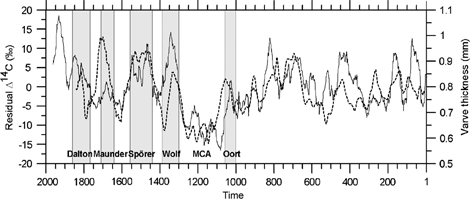Reference
Haltia-Hovi, E., Saarinen, T. and Kukkonen, M. 2007. A 2000-year record of solar forcing on varved lake sediment in eastern Finland. Quaternary Science Reviews 26: 678-689.
What was done
The authors extracted sediment cores from beneath the 0.7-m-thick ice platform on Lake Lehmilampi (63°37'N, 29°06'E) in North Karelia, eastern Finland, in the springs of 2004 and 2005, after which they identified and counted the approximately 2000 annual varves contained in the cores and measured their individual thicknesses and mineral and organic matter contents. These climate-related data were then compared with residual Δ14C data derived from tree rings, which serve as a proxy for solar activity.
What was learned
Haltia-Hovi et al. report that their "comparison of varve parameters (varve thickness, mineral and organic matter accumulation) and the activity of the sun, as reflected in residual Δ14C [data] appears to coincide remarkably well in Lake Lehmilampi during the last 2000 years, suggesting solar forcing of the climate," as depicted in the figure below for the case of varve thickness.

Residual Δ14C data (dashed line) and varve thickness (smooth line) vs. time, specifically highlighting the Oort, Wolf, Sporer, Maunder and Dalton solar activity minima, as well as the "Medieval Climate Anomaly (also referred to as Medieval Warm Period)," during the contemporaneous "solar activity maxima in the Middle Ages." Adapted from Haltia-Hovi et al. (2007).
What it means
"In Lake Lehmilampi," to quote the Finnish researchers, "the low deposition rate of mineral matter in AD 1060-1280 [shown in another of their figures] possibly implies mild winters with a short ice cover period during that time with minor snow accumulation interrupted by thawing periods." Likewise, they say that the low accumulation of organic matter during this period [also shown in another of their figures] "suggests a long open water season and a high decomposition rate of organic matter." Consequently, since the AD 1060-1280 period shows by far the lowest levels of both mineral and organic matter content, and since "the thinnest varves of the last 2000 years were deposited during [the] solar activity maxima in the Middle Ages," it is difficult not to conclude that that period was likely the warmest of the past two millennia in the part of the world studied by the three scientists.




